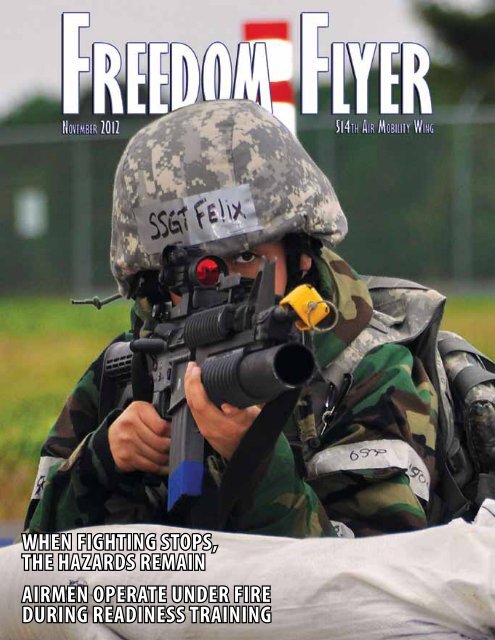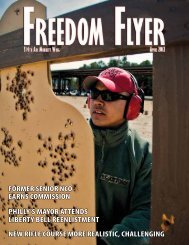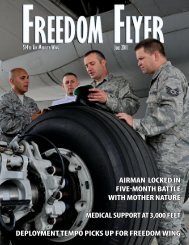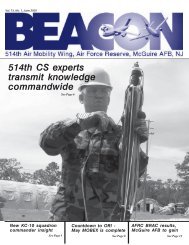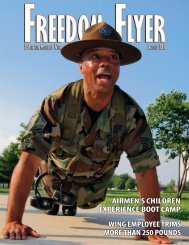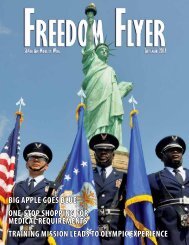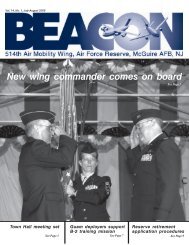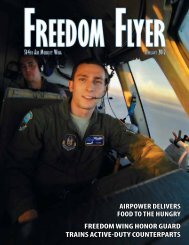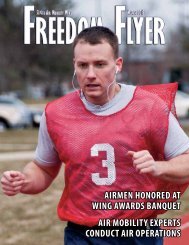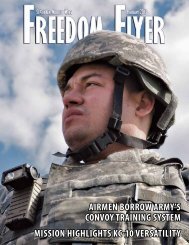here for the November issue of Freedom Flyer magazine - 514th Air ...
here for the November issue of Freedom Flyer magazine - 514th Air ...
here for the November issue of Freedom Flyer magazine - 514th Air ...
Create successful ePaper yourself
Turn your PDF publications into a flip-book with our unique Google optimized e-Paper software.
<strong>Air</strong>men fill <strong>the</strong> cargo compartment <strong>of</strong> a C-17Globemaster III near <strong>the</strong> end <strong>of</strong> an operationalreadiness exercise <strong>here</strong> Oct. 16. During <strong>the</strong> exercise,<strong>Air</strong>men practiced per<strong>for</strong>ming <strong>the</strong>ir duties ina hostile environment.Photo by Shawn J. Joneswww.facebook.com/<strong>514th</strong><strong>Air</strong>MobilityWing<strong>Freedom</strong> <strong>Flyer</strong> 3
ViewPointsPhotos by Shawn J. JonesTech. Sgt. Lois Geter, 35th Aerial Port Squadron, measures <strong>the</strong> weight <strong>of</strong> Staff Sgt. Richard Weincek, <strong>514th</strong> <strong>Air</strong>craft Maintenance Squadron, as part <strong>of</strong> passenger check-in procedures prior to boardingan aircraft during an operational readiness training exercise <strong>here</strong> Oct. 16.Preparing <strong>for</strong> <strong>the</strong> readiness inspection: Individual requirementsBy Maj. Regina Reyes<strong>514th</strong> Force Support SquadronIs your gear ready? Is your training complete?Is your <strong>Air</strong>man’s Manual tabbed?For an <strong>Air</strong>man participating in an operationalreadiness inspection, t<strong>here</strong> can be alot to do in a short period <strong>of</strong> time. As <strong>the</strong>wing quickly approaches April’s readinessinspection, <strong>the</strong> <strong>514th</strong> Force Support Squadronwould like <strong>for</strong> you to consider a fewadditional preparedness questions:• Is your virtual record <strong>of</strong> emergency data(DD <strong>for</strong>m 93) current and accurate? If not,navigate to <strong>the</strong> virtual military personnelflight in order to update <strong>the</strong> data. Not only isthis important <strong>for</strong> <strong>the</strong> inspection, but currentand accurate emergency data is crucial <strong>for</strong>real-world accountability.• Review your servicemembers & veteransgroup life insurance coverage and elections.Are <strong>the</strong>y up-to-date? If you requirechanges, visit <strong>the</strong> <strong>for</strong>ce support squadron’scustomer support section.• Do you have identification tags, o<strong>the</strong>rwiseknown as dog tags? If you don’t, or if<strong>the</strong>y need to be updated, contact your unitdeployment manager or <strong>514th</strong> FSS readinesssection at 754-4957.With his <strong>Air</strong>man’s Manual and mobility folder in hand, Senior<strong>Air</strong>man Shivam Patel prepares to deploy to a hostile environmentas part <strong>of</strong> a readiness training exercise in October. Patel, afull-time civil engineering student at Penn State University, is areservist serving with <strong>the</strong> 714th <strong>Air</strong>craft Maintenance Squadron.• Is your family care plan current? Discussany <strong>issue</strong>s with your first sergeant assoon as you become aware <strong>of</strong> <strong>the</strong>m.• Is your common access card valid, orwill it be expiring soon? See <strong>the</strong> customersupport section if you need a new one.• Does <strong>the</strong> military personnel data systemshow that you are medically ready? If youhave a deployment availability code in <strong>the</strong>system due to a previous medical readiness<strong>issue</strong>, it can cause an unnecessary delay in<strong>the</strong> deployment line or it may keep you fromdeploying altoge<strong>the</strong>r. Ask your deploymentmanager if you have a code in <strong>the</strong> systemthat needs to be removed.• Did you know that you need to handcarryyour on-<strong>the</strong>-job training records to <strong>the</strong>exercise and inspection area? If your recordsare online, <strong>the</strong>y should be downloaded andhand-carried on approved electronic media.• Speaking <strong>of</strong> gear, do you have <strong>the</strong> clothingand hygiene items required <strong>for</strong> deployment?You don’t want to be caught without<strong>the</strong> right gear, so take a look at appendix 21<strong>of</strong> <strong>the</strong> installation deployment plan <strong>for</strong> <strong>the</strong>complete list. Remember, April may still becold and rainy.This list is certainly not all-inclusive,but hopefully it will get you to start thinkingabout <strong>the</strong> various preparations that arerequired between now and April. For those<strong>of</strong> you who participated in <strong>the</strong> readinessexercise in October, you’re already a stepahead. Regardless, one <strong>of</strong> <strong>the</strong> most importantthings you can do is to get to knowyour deployment manager. Ask <strong>the</strong>m yourreadiness questions. If <strong>the</strong>y don’t know<strong>the</strong> answer, <strong>the</strong>y’ll know how to find it.Toge<strong>the</strong>r, we can demonstrate our capabilitiesin a wartime environment and make <strong>the</strong>inspection a successful event.www.facebook.com/<strong>514th</strong><strong>Air</strong>MobilityWing<strong>Freedom</strong> <strong>Flyer</strong> 5
War GamesBy 2nd Lt. David J. Murphy87th <strong>Air</strong> Base Wing Public Affairs&Shawn J. Jones<strong>Freedom</strong> <strong>Flyer</strong> editorSix upset civilians ga<strong>the</strong>r at <strong>the</strong> main gate. Firefighters and security <strong>for</strong>ces<strong>Air</strong>men soon arrive in case <strong>the</strong> ga<strong>the</strong>ring turns into a full-fledged protest. At<strong>the</strong> same time, a vehicle speeds toward <strong>the</strong> ga<strong>the</strong>ring, and just be<strong>for</strong>e it reaches<strong>the</strong> gate, two gunmen exit and detonate a bomb within <strong>the</strong> vehicle. <strong>Air</strong>menengage <strong>the</strong> gunmen and drive <strong>the</strong>m <strong>of</strong>f, allowing <strong>the</strong>ir fellow <strong>Air</strong>men to getback to <strong>the</strong> mission <strong>of</strong> providing mobility support missions over eastern Asia.This was just one <strong>of</strong> many training scenariosexecuted during <strong>the</strong> operational readinessexercise <strong>here</strong> Oct. 10 - 17.The week-long exercise – a combinedef<strong>for</strong>t between <strong>the</strong> Reserve <strong>Air</strong>men <strong>of</strong> <strong>the</strong><strong>514th</strong> <strong>Air</strong> Mobility Wing and <strong>the</strong> active-duty<strong>Air</strong>men <strong>of</strong> <strong>the</strong> 87th <strong>Air</strong> Base Wing and 305thAerial Port Squadron – was designed to prepareservice members <strong>for</strong> <strong>the</strong> upcoming Apriloperational readiness inspection. During <strong>the</strong>exercise, command staff personnel are ableto observe <strong>the</strong> readiness <strong>of</strong> <strong>the</strong>ir <strong>Air</strong>men andhow <strong>the</strong>y would per<strong>for</strong>m in a hostile environment.The exercise took service membersthrough <strong>the</strong> process <strong>of</strong> a deployment, startingfirst with <strong>the</strong> mobility phase, followedby <strong>the</strong> deployment and employment phaseand concluding with <strong>the</strong> redeployment anddemobilization phase.“The exercise is an evaluation <strong>of</strong> our preparedness,”said Lt. Col. Tony Polashek, <strong>the</strong>acting commander <strong>of</strong> <strong>the</strong> <strong>514th</strong> OperationsGroup, who during <strong>the</strong> exercise served assecond-in-command to Col. Michael Underk<strong>of</strong>ler,<strong>514th</strong> AMW commander. “It tests ourability to deploy and operate efficiently in adeployed environment.”The event featured a number <strong>of</strong> differentscenarios that challenged service membersin every field.Besides aggravated protestors and aggressivegunmen, <strong>the</strong> <strong>Air</strong>men were evaluated in<strong>the</strong>ir ability to respond to simulated missileattacks, chemical weapons attacks, gasspills, communication systems breakdownsand many o<strong>the</strong>r challenges associated with ahostile environment.6 <strong>Freedom</strong> <strong>Flyer</strong> www.514amw.afrc.af.mil
The <strong>Air</strong>men’s reactions to <strong>the</strong> scenarioswere observed by an exercise evaluationteam. The evaluation team takes notes, providesfeedback and writes a summary reportto help <strong>the</strong> <strong>Air</strong>men identify areas <strong>of</strong> focusas <strong>the</strong>y prepare <strong>for</strong> <strong>the</strong> readiness inspection.“We are working to ensure <strong>the</strong>y are incompliance with <strong>the</strong>ir mission-essentialtask lists, <strong>the</strong>ir functional areas and <strong>the</strong>irindividual tasks,” said Robert Sc<strong>here</strong>r, 87thABW chief <strong>of</strong> exercise services. “We alsoevaluated attitude, sense <strong>of</strong> urgency, leadership,team work and compliance with <strong>the</strong>ir(ability to survive and operate) tasks.”Attitude was one area w<strong>here</strong> servicemembers excelled, said Chief Master Sgt.James Whiteley, <strong>514th</strong> <strong>Air</strong>craft MaintenanceSquadron superintendent and actingcommand chief master sergeant <strong>of</strong> <strong>the</strong> <strong>514th</strong>AMW.“Attitudes were great, everyone was verypositive,” said Whiteley. “They wanted todo it and <strong>the</strong>y wanted to do a good job.”<strong>Air</strong>men had plenty <strong>of</strong> opportunities todisplay <strong>the</strong>ir positive attitudes as <strong>the</strong> evaluationteam kept <strong>the</strong>m busy with overlappingtraining scenarios.“Our <strong>Air</strong>men faced <strong>the</strong> entire gamut<strong>of</strong> possible <strong>the</strong>ater security threats andleadership challenges. At any onetime, multiple simulated emergencieswere occurring,” Underk<strong>of</strong>lersaid. “Everyone wasfully engaged, resolvingproblems or protectingresources.”The exercise not onlychallenged <strong>the</strong> <strong>Air</strong>menwho participated, butalso posed many challengesto exercise plannerswho had to createa hostile environment in <strong>the</strong> midst <strong>of</strong> t<strong>here</strong>gular day-to-day operations <strong>of</strong> <strong>the</strong> base.Deploying <strong>Air</strong>men to one <strong>the</strong> <strong>Air</strong> Force’sfour contingency readiness training centersprovides an isolated and realistic trainingarea specifically designed <strong>for</strong> readinessexercises, but Underk<strong>of</strong>ler said training at<strong>the</strong> home station allows <strong>the</strong> wings to be bettercustodians <strong>of</strong> taxpayers’ money.“One <strong>of</strong> <strong>the</strong> best things to come from thishome-station exercise was learning moreabout <strong>the</strong> constraints and capabilities <strong>of</strong> <strong>the</strong>installation,” he said. “It ought to make us allbetter at providing a coordinated responseshould we confront a real-world threat oremergency <strong>here</strong>.”Units will have <strong>the</strong> opportunityto test <strong>the</strong>ir abilities again duringano<strong>the</strong>r exercise scheduled<strong>for</strong> January.<strong>Freedom</strong> <strong>Flyer</strong> 7
Inspection PrepJoe ATSO knows readiness“Joe, how frequently should I inspect my M50 protective mask and howdo I document <strong>the</strong> inspection?”<strong>Air</strong>men should inspect <strong>the</strong>ir M50, joint service general purpose mask when itis initially <strong>issue</strong>d, after each use, semi-annually and when ordered to do so in acontingency environment, usually every seven days. The inspection <strong>of</strong> <strong>the</strong> M50must be documented on a DD Form 1574 and must be kept with <strong>the</strong> mask at alltimes. The best place to store <strong>the</strong> <strong>for</strong>m is in <strong>the</strong> back storage pocket <strong>of</strong> <strong>the</strong> maskcarrying case.“Joe, what do I do if I need to take a drink while wearing my mask?”Maintaining proper hydration helps <strong>of</strong>fset <strong>the</strong> effects <strong>of</strong> <strong>the</strong>rmal build-up dehydration.A serviceable M50 water canteen cap has to be installed on <strong>the</strong> canteento drink through <strong>the</strong> mask. The drinker, using <strong>the</strong> buddy system, will maintain aproper mask seal and <strong>the</strong> ‘buddy’ will help per<strong>for</strong>m <strong>the</strong> following steps to have hisor her wingman safely drink from <strong>the</strong> canteen in a contaminated environment.Individuals should:1. Decontaminate <strong>the</strong> M50 canteen, canteen cap and drinking tube coupler wi<strong>the</strong>i<strong>the</strong>r a M291 or M295 skin decontaminating kit.2. Open <strong>the</strong> retaining strap on <strong>the</strong> water canteen cap.3. Push <strong>the</strong> drink coupler into <strong>the</strong> canteen cap so <strong>the</strong> coupler snaps into <strong>the</strong> grooveand creates a seal.4. Turn <strong>the</strong> drink tube lever on <strong>the</strong> front module assembly upward until it stopsand is fully opened. The drinker should grasp <strong>the</strong> internal drink tube between hisor her lips.5. Blow to create positive pressure. Some resistance should be felt.6. Raise and invert <strong>the</strong> canteen to drink <strong>the</strong> water.“What are <strong>the</strong> three levels <strong>of</strong> decontamination?”The levels are: immediate, operational and thorough!1. “Immediate” applies to individual’s skin, personal clothing, equipment andfrequently touched surfaces. This type <strong>of</strong> decontamination should be done as soonas contamination is suspected or detected.2. “Operational” applies to individuals, crews, teams, or units and <strong>the</strong>ir essentialoperational equipment, work areas, vehicles and material. This level <strong>of</strong> decontaminationshould be per<strong>for</strong>med when operations require and when resources permit.3. “Thorough” includes units or wings, with or without external support and mustdecontaminate all personnel (by setting up a Contamination Control Area), equipment,material, vehicles, aircraft, work areas and terrain.Decontaminating personnel and resources limits <strong>the</strong> spread <strong>of</strong> contamination.The M-291 skin decontamination kit and M-295 individual equipment decontaminationkit are used to accomplish Immediate immediate and Operationaloperational decontamination.“How do I properly don and clear my M50 Mask?”Great question! A few things to keep in mind be<strong>for</strong>e donning a personal mask isensure females let <strong>the</strong>ir hair down if in a bun and remove hair fasteners or earringsthat could interfere with <strong>the</strong> mask seal. Do not wear contact lenses while wearing<strong>the</strong> mask. Members should, once ordered to don <strong>the</strong> mask, follow <strong>the</strong>se steps:1. Members should close <strong>the</strong>ir eyes and hold <strong>the</strong>ir breath.2. Remove headgear and glasses, if worn.3. Raise <strong>the</strong> mask to <strong>the</strong> face, <strong>the</strong>n place <strong>the</strong> chin in <strong>the</strong> chin cup.4. Brow and temple straps should have already been adjusted, so no fur<strong>the</strong>radjustments should be needed to <strong>the</strong>se straps.5. Members should grasp <strong>the</strong> head harness tab and pull over <strong>the</strong>ir head. Pull down<strong>the</strong> head harness at <strong>the</strong> back as far as possible so <strong>the</strong> brow straps are tight andtemple straps are parallel to <strong>the</strong> ground.6. Tighten <strong>the</strong> cheek straps one at a time or both at <strong>the</strong> same time, ensuring strapslay flat against <strong>the</strong> head.Seal <strong>the</strong> outlet disk valve by placing one hand over <strong>the</strong> outlet valve cover assemblyto clear <strong>the</strong> mask. Blow out hard to ensure that any contaminated air is <strong>for</strong>ced outaround <strong>the</strong> edges <strong>of</strong> <strong>the</strong> mask assembly. Ensure hands completely cover <strong>the</strong> M61filter air inlet passages on both filters and brea<strong>the</strong> in to conduct negative pressuretest. The mask should collapse and remain collapsed while <strong>the</strong> member holds <strong>the</strong>irbreath. Check <strong>for</strong> hair, clothing, or o<strong>the</strong>r matter between mask and skin and clearagain if <strong>the</strong> mask does not collapse.8 <strong>Freedom</strong> <strong>Flyer</strong> www.514amw.afrc.af.mil
Self-aid, buddy care skills crucial to inspection successBy Chief Master Sgt. Chryl Ruff<strong>514th</strong> Aerospace Medicine SquadronBy Tech. Sgt. Dustin Heines<strong>514th</strong> Civil Engineer SquadronThe dangers associated with a conventionalattack do not end when <strong>the</strong> weaponsstop firing. Immediately after an attack,<strong>Air</strong>men must deal with <strong>the</strong> hazards <strong>of</strong> unexplodedordnance.Though <strong>the</strong> duty <strong>of</strong> discovering and controllingunexploded ordnance typically fallson post-attack reconnaissance teams ando<strong>the</strong>r first responders, every <strong>Air</strong>men shouldbe familiar with <strong>the</strong> procedures <strong>for</strong> dealingwith unexploded ordnance. The proceduresare broken down into steps known as <strong>the</strong>Five C’s: confirm, clear, cordon, check andcontrol.Confirm: When <strong>Air</strong>men discover whatappears to be unexploded ordnance, <strong>the</strong>yshould do <strong>the</strong>ir best to safely confirm that itis not debris, garbage or an unrelated piece<strong>of</strong> equipment. Improper identification canwaste <strong>the</strong> vital time <strong>of</strong> o<strong>the</strong>r first responders.<strong>Air</strong>men should also try to get a goodPhoto by Shawn J. JonesSenior <strong>Air</strong>man Kathryn Carru<strong>the</strong>rs, 732nd <strong>Air</strong>liftSquadron, demonstrates how to apply a wounddressing on Tech. Sgt. Tim Mullin, 88th AerialPort Squadron, during a self-aid and buddy caretraining class Sept. 8.look at <strong>the</strong> suspected ordnance so <strong>the</strong>y mayproperly report its classification by referencing<strong>the</strong>ir <strong>Air</strong>man’s Manual. Accuratelyreporting <strong>the</strong> ordnance location using buildingnumbers or <strong>the</strong> military grid referencesystem is also important. Classification andlocation in<strong>for</strong>mation allows <strong>the</strong> ordnancedisposal specialists to prioritize post-attackhazards.Clear & Cordon: The next two C’s arehandled in conjunction. <strong>Air</strong>men shouldclear all personnel from <strong>the</strong> area surrounding<strong>the</strong> ordnance and cordon <strong>of</strong>f <strong>the</strong> ordnanceso o<strong>the</strong>r personnel will stay clear. Forordnance that are five inches in diameter orless, which includes most mortars, <strong>Air</strong>menshould be clear and cordon <strong>of</strong>f areas 300feet from <strong>the</strong> location. A 500-foot cordonshould surround ordnance between five andten inches in diameter, and a 1,000-footcordon should surround ordnance betweenten and twenty inches in diameter.Check: <strong>Air</strong>men must be sure to thoroughlycheck <strong>the</strong> surrounding area <strong>for</strong> morewww.facebook.com/<strong>514th</strong><strong>Air</strong>MobilityWingDuring <strong>the</strong> operational readiness inspection,<strong>Air</strong>men will be evaluated on <strong>the</strong>ir ability to rendermedical care in emergency conditions. Hereare a few self-aid and buddy care tips to help<strong>Air</strong>men shine during <strong>the</strong> inspection:Prioritize: <strong>Air</strong>men should focus on threatsto <strong>the</strong>ir patient’s airway, breathing and circulation.Minor injuries, such as a broken wrist ora twisted ankle, can wait to be treated, but anobstructed airway, shortness <strong>of</strong> breath or majorbleeding can kill if not quickly recognized andtreated.Differentiate between conventional care andcare under fire. In most cases, <strong>Air</strong>men shouldstick to <strong>the</strong> priorities mentioned above. However,in certain circumstances, it is more importantto stop <strong>the</strong> bleeding first. In a care-underfirescenario, <strong>Air</strong>men who are in immediatedanger, should adjust <strong>the</strong> priority to maximizesurvivability <strong>of</strong> <strong>the</strong>mselves and <strong>the</strong>ir patient.In this situation, <strong>the</strong> only aid an <strong>Air</strong>men shouldprovide is to stop major bleeding with a tourniquet,be<strong>for</strong>e seeking safety. All o<strong>the</strong>r medical interventions mustwait, because <strong>the</strong>y take up too much time and attention away fromreturning fire or taking cover.Re-assess your buddy. Self aid and buddy care interventionsare not definitive medical care. However, when pr<strong>of</strong>essional medicalpersonnel are not available, <strong>Air</strong>men may have to render care<strong>for</strong> a prolonged period. In <strong>the</strong> period after an attack, known as“alarm black,” <strong>Air</strong>men should expect to spend some time waitingbe<strong>for</strong>e base leaders determine <strong>the</strong> area is safe to return to normaloperations. <strong>Air</strong>men cannot evacuate casualties during this alarmcondition. While waiting <strong>for</strong> <strong>the</strong> chance to get casualties to definitivemedical care, <strong>Air</strong>men should not <strong>for</strong>get t<strong>of</strong>requently reassess <strong>the</strong> basic priorities – airway,breathing and circulation. If t<strong>here</strong> are multiplecasualties, an <strong>Air</strong>man should be assigned tokeep an eye on <strong>the</strong>m. When wearing <strong>the</strong> fullchemical protective ensemble, a buddy checkcan be a simple as asking <strong>for</strong> a thumbs-up toensure <strong>the</strong> patient is doing well enough to followdirections.Keep real-world threats in mind. Operatingin chemical protective gear is a big part <strong>of</strong> <strong>the</strong>“fight” part <strong>of</strong> an <strong>Air</strong>man’s fit-to-fight physicalreadiness. The minute <strong>Air</strong>men don <strong>the</strong> gear, <strong>the</strong>irhearts and lungs have to work a little harder toaccommodate <strong>the</strong> extra weight. The protectivemask limits peripheral vision, <strong>the</strong> gloves andboots limit dexterity and <strong>the</strong> operational tempoand scrutiny <strong>of</strong> an inspection can contribute to<strong>the</strong> overall stress load.Some common sense countermeasures bearrepeating <strong>for</strong> <strong>Air</strong>men participating in <strong>the</strong> readinessexercises and inspection. They shouldn’tsmoke. They should maintain a good cardiovascularfitness routine. They should also drinkplenty <strong>of</strong> water and o<strong>the</strong>r hydrating fluids twoto three days be<strong>for</strong>e <strong>the</strong> exercise <strong>for</strong> best results, and be familiarwith your mask hydration system. Alcohol and greasy food shouldbe avoided be<strong>for</strong>e and during <strong>the</strong> exercise. If <strong>Air</strong>men begin to feelclaustrophobic in <strong>the</strong>ir chemical gear, <strong>the</strong>y should slow down andtry to focus on making <strong>the</strong>ir breathing slow and even. If <strong>the</strong>y continueto struggle, <strong>the</strong>y should ask a buddy <strong>for</strong> help readjusting <strong>the</strong>gear more com<strong>for</strong>tably. <strong>Air</strong>men should get real-world help if <strong>the</strong>ycan’t get <strong>the</strong>ir breathing under control or if <strong>the</strong>y become dizzy orfeel sick.These tips will go along way in protecting <strong>Air</strong>men in <strong>the</strong> inspection’straining scenarios and in <strong>the</strong> real world situations.Unexploded ordnance: When fighting stops, hazards remainhazards. Just because one unexploded ordnancewas discovered in an area doesn’tmean t<strong>here</strong> isn’t a second or third awaitingdiscovery. Post-attack reconnaissanceteams should proceed with <strong>the</strong>ir sweeps,checking inside and outside <strong>the</strong> cordon distance.Control: If <strong>the</strong> cordon distance is blockinga roadway, <strong>the</strong> road must be blocked<strong>of</strong>f and closed. This may entail assigning<strong>Air</strong>men to ensure <strong>the</strong> road stays blocked tonon-essential personnel.Once <strong>the</strong> five C’s are completed, it isimperative to not remain in a danger areathat has been cleared and cordoned <strong>of</strong>f.Remain on scene long enough to providein<strong>for</strong>mation to ordnance disposal specialistsor o<strong>the</strong>r emergency responders.The quicker <strong>the</strong>se first responderscan attack <strong>the</strong> hazard, <strong>the</strong> faster <strong>the</strong> basecan return to normal operations. Properreporting, coordination, and following <strong>the</strong>five C’s guarantee this happens as efficientlyas possible.<strong>Freedom</strong> <strong>Flyer</strong> 9
Pulse Check: What are some <strong>of</strong> your goals <strong>for</strong> <strong>the</strong> upcoming year?<strong>Air</strong>man 1st ClassMargaret Brown<strong>Air</strong>man 1st ClassJermaine HussettSenior <strong>Air</strong>manGerman BritoMaster Sgt.Nile MarshallStaff Sgt.Eddie Mendoza714th <strong>Air</strong>craftMaintenance Squadron88th AerialPort Squadron<strong>514th</strong> ForceSupport Squadron<strong>514th</strong> SecurityForces Squadron<strong>514th</strong> ForceSupport Squadron“I want to get my own place,start college, fur<strong>the</strong>r my <strong>Air</strong>Force and civilian careers andmeet new people.”“My plans are to go back toschool <strong>for</strong> a major in criminaljustice and a minor in aviation,while serving my country.”“I plan to complete myupgrade training and treat myparents to a nice, long vacationto whatever destination<strong>the</strong>y choose.”“I believe goals are good <strong>for</strong>some individuals, but I concentratemore on enjoying lifeday to day. Life is short, and at50, it is even shorter!”“I want to get settled in mynew apartment, enroll in collegeand get promoted.”<strong>Freedom</strong> Wing’s C-17 Globemaster III Flying BreakdownOct. 1, 2011 — Oct. 1, 2012Global & Channel MissionsFlight hours: 3,165Passengers: 8,098Cargo short tons: 161,711Sorties: 741Training MissionsFlight hours: 824Passengers: 1,666Cargo short tons: 933Sorties: 27810 <strong>Freedom</strong> <strong>Flyer</strong> www.514amw.afrc.af.milIllustration by Shawn J. Jones
The following <strong>Air</strong>menwere recently promoted.<strong>Air</strong>manJonathan Bregman, 35th APSGabriele Eder, 514 ASTSEddie Gallego, 714 AMXSJoseph Lorenzo, 514 AMXSJillian Moran, 514 AMDSAnthony Serrano, 35 APSMarcos Tapia, 514 AMDSAlex Torres, 714 AMXSJeremiah Warren, 42 CBCSAmeer Wilson, 514 AMXS<strong>Air</strong>man 1st ClassHassan Pierce, 514 FSSSenior <strong>Air</strong>manTimothy Horbach, 88 APSOlanrewaju Jeje, 514 AMXSEric Lee, 714 AMXSSilvio Ng III, 514 AMDSLauren Ortiz, 514 AESXochil Ramirez, 35 APSMichael Roberts, 88 APSJose Salas, 35 APSChad Turko, 714 AMXSCarolina Vergara, 35 APSStaff SergeantCourtney Bales, 514 MOFJames Del Rio, 88 APSJoseph VanMorter, 514 AMXSTechnical SergeantNachole Carlson, 514 LRSAndrew Dunn, 514 OSSTimothy Finch, 514 AMOSRyan Horn, 514 MXSPhilip Jawny, 514 SFSDenes Papellas, 78 ARSRaul Rodriguez, 514 AMWMaster SergeantMiriam Gelo, 514 ASTSShawn Jones, 514 AMWDennis Wallace, 714 AMXSChief Master SergeantRobert Henderson, 714 AMXSSpotlight:Photo by Master Sgt. Donna T. JeffriesMaster Sgt. David TingleRecruiting Service Annual AwardsReserve Recruiting Service Wing Commander <strong>of</strong> <strong>the</strong> YearCol. Michael Underk<strong>of</strong>lerOperating Location Superior Per<strong>for</strong>manceTeam McGuireCentral Recruiting Squadron Senior Recruiter <strong>of</strong> <strong>the</strong> YearSenior Master Sgt. Marvin GreeneSuperior Per<strong>for</strong>manceMaster Sgt. Pedro ConsuegraMaster Sgt. Nick SeylerMaster Sgt. Thomas McCuneTech. Sgt. Jose DiazTech. Sgt. Derrick FieldsUnit: <strong>514th</strong> Security Forces SquadronPosition: Noncommissioned Officer in Charge <strong>of</strong> TrainingHometown: Edison, N.J.Civilian employment: Edison Police OfficerLittle known fact about you: My nickname is “<strong>the</strong> Prince”Most delicious dish ever: My wife’s chicken parmesanSomething high on your bucket list: Taking my kids to Disney WorldWhat movie do you never get tired <strong>of</strong> watching: Pulp FictionMost eye-opening moment: The day my daughter was bornNew number <strong>for</strong> help desk requestsWhen assistance is needed <strong>for</strong> computer <strong>issue</strong>s, <strong>Freedom</strong> Wing<strong>Air</strong>men will now call <strong>the</strong> <strong>Air</strong> Force Enterprise Service Desk. To initiatea service request, <strong>Air</strong>men should call (210) 925-2900 or DSN945-2900. Each request will be assigned a ticket number, whichcan be used to follow up on <strong>the</strong> request with service desk personnelor with <strong>the</strong> technicians at <strong>the</strong> wing’s client service center. Thoughservice requests will no longer be initiated locally, <strong>the</strong> wing technicianswill continue to provide hands-on support as needed.www.facebook.com/<strong>514th</strong><strong>Air</strong>MobilityWingPerson you respect and why: My wife <strong>for</strong> always supporting me duringmy military career and my deployments.A phrase your mom or dad always said: Treat o<strong>the</strong>rs as you wouldwant to be treated.What is your most memorable gift to someone: While working as apolice <strong>of</strong>ficer in Edison, I had <strong>the</strong> opportunity to bring someone back to life.Something your child says that regularly stumps you: Just <strong>the</strong>simple question “why” after just about everything I tell <strong>the</strong>m.<strong>Freedom</strong> <strong>Flyer</strong> 11
<strong>Freedom</strong> <strong>Flyer</strong><strong>514th</strong> <strong>Air</strong> Mobility Wing Public Affairs2217 W. Arnold Ave.Joint Base McGuire-Dix-Lakehurst, NJ 08641For <strong>the</strong> family <strong>of</strong>:<strong>Air</strong>men board a C-17 Globemaster III near<strong>the</strong> conclusion <strong>of</strong> <strong>the</strong> week-long operationalreadiness exercise Oct. 16.Photo by Shawn J. Jones


